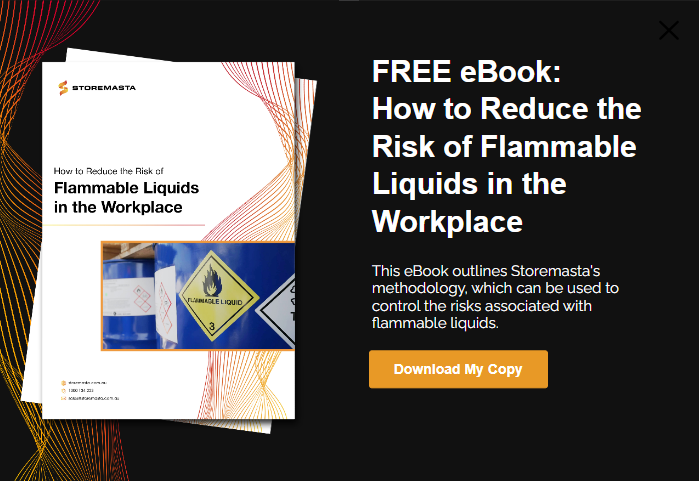While flammable liquids are recognised as hazardous and volatile chemicals, many workplace accidents involving these Class 3 Dangerous Goods could have been prevented. When working with flammable liquids, it’s important for staff to have an in-depth understanding of the substance — so they’re familiar with the chemical’s flash point as well as the fire and explosion limits. Sadly, workplace accidents that involve flammable liquids commonly result in catastrophic explosions which cause terrible injuries to workers. In this blog, we look at 5 deadly mistakes staff make when handling flammable liquids. We’ll explain the risks and hazards of each situation, so you can train your staff and supervisors on how to avoid these dangers.
Deadly Mistake #1. Using Petrol Or Gasoline To Accelerate A Fire
An employee at a job site that manufactures wooden windows and doors went to light a wood fire in a furnace. Starting the fire with wood and kindling, he also placed petrol in the firebox to accelerate the fire. The vapours ignited instantly and flashed over the employee, who caught on fire. He died from second and third degree burns.
Many workers don’t understand that it’s the flammable vapours, not the actual liquid, that ignites and burns.
When you throw petrol, solvents or other accelerants onto a fire, the flames will follow the vapours back to the source. Unfortunately, the source is usually a worker’s hand which is holding the fuel bottle or container.
Even if the flammable liquid giving off the vapour is located a long distance from an ignition source (even 100 metres away), flashback and fire can still occur.

Flammable vapours can quickly ignite, with the fire capable of travelling back to the source in an instant.
Do you have areas at your worksite where staff are required to light furnaces or burn materials? You must always ensure that your staff have sufficient materials to ignite the fire safely — and are fully trained to know not to use accelerants. Make sure that your staff are trained to understand the chemical properties of the flammable liquids that they are handling as well as the hazardous vapours that they emit.
Deadly Mistake #2. Bringing An Ignition Source Into An Area Containing Flammable Liquids
A worker was transferring a flammable liquid called RC-250 (a type of asphalt) from a tank to his truck. When he finished, the workers realised that the transfer line had become stuck because of the extremely cold weather. He attempted to unfreeze the line with a propane blow torch. The fuel instantly ignited causing an explosion. Sadly, the worker was killed in the accident.
The Australian Standard AS 1940:2017 - The storage and handling of flammable and combustible liquids states that ignition sources must not be brought into areas where flammable liquids are stored, handled or dispensed. This includes bulk storage tanks, packaging areas, minor stores and fill points.

Ignition sources, such as blow torches, must be kept at least 3 metres from flammable liquids.
In this horrifying accident, it’s clear that the worker didn’t understand the hazards of working with RC-250. He should have been trained to understand the chemical’s reactivity, flash point and explosion limits to avoid such a disaster.
It’s crucial that all staff who are handling flammable liquids be given thorough safety training. Make sure that your staff are:
- Familiar with the Safety Data Sheets (SDSs) of the flammable liquids they use and have a full understanding of their chemical properties — eg, generic SDSs for RC-250 state the chemical should not be exposed to heat, flames and oxidisers.
- Conversant with ignition sources (naked flames, welding arcs, mechanical sparks, electrical discharge from static electricity, machine heat) that could ignite the flammable liquids.
- Aware of their personal responsibilities under WHS Regulations and Australian Standards.
- Able to prepare their work areas safely and follow correct procedures (eg, earthing and bonding, liquid dispensing, spill response, waste removal).
IMPORTANT: There must be no uncontrolled sources of ignition in any space in which a flammable mixture of vapour and air could be present.
Deadly Mistake #3. Using Incorrect Decanting Methods
A new employee working alone in a warehouse was transferring the solvent acetone from an elevated Intermediate Bulk Container (IBC) to another container located on the ground. He used the forklift to elevate the IBC, but the transfer hose broke and acetone liquid began to spill out on the floor. Unable to reach the main valve, he tried using the forklift again to manoeuvre the IBC. At the same time, acetone vapours reached the hot surface of the forklift engine and ignited. The worker received third degree burns to more than 60% of his body and died one month later from his injuries.
Great care should be taken when decanting or transferring flammable liquids — and staff need thorough training to perform these everyday tasks.
New workers particularly require additional supervision and should never be left alone to handle Dangerous Goods.

Decanting and transferring flammable liquids can be a dangerous task, so consider installing an all-in-one dispensing station.
Using a flammable liquids dispensing station designed in accordance with AS1940 is an excellent way of reducing the risk of spills and dispersion of flammable vapours.
One way to avoid such an accident is by implementing better methods of decanting or transferring Class 3 Flammable Liquids. Choosing to install a dispensing station at your worksite will allow staff to store and dispense flammable liquids from a single unit. You should consider a fully enclosed station that’s fitted with a spill containment sump and natural ventilation system, as well as hose reels, dispensers and pumps. This allows for the simple and safe decanting of liquids by minimising the risk and the impact of chemical spills.
Deadly Mistake #4. Not Bonding Dispensing Equipment
A worker was dispensing fuel from large drums into small bottles. He was using drums, a pump, polyurethane hose, a liquid filling machine, and the small bottles. Most of the equipment was grounded, however, the polyurethane hose had not been correctly bonded. Static electricity ignited a flash fire. The employee was hospitalised after suffering first and second degree burns.
When transferring flammable liquids into another container or tank, all the dispensing equipment (piping, tanks, valves, containers etc) must be bonded continuously.
Fuel passing through a hose and between containers creates static electricity. The static electricity commonly discharges when a nozzle is being removed from a tank that is being filled.
The process of bonding ensures that an electrically conductive pathway between a dispensing container and a receiving container is always grounded.
Therefore, make sure that your dispensing stations have bonding systems in place — and staff are trained on the importance of bonding. Personnel need to aware of the risks to their own health and safety if they dispense fuel without grounding the equipment. It’s also important that staff correctly follow safety procedures, so make sure that there’s adequate supervision when chemicals are being transferred.
Deadly Mistake #5. Not Maintaining Vapours Within Safe Exposure Levels
An employee was using a flammable solvent to remove linoleum adhesive from the floor of a laundry room. The laundry was empty except for some cabinets, a hot water system and solar storage tank. Working with the doors closed and only a window open, the room did not receive adequate ventilation as the flammable vapours were released. The heating elements from the hot water system ignited the solvent vapours causing an explosion and flash fire. The employee died from injuries he sustained in the fire including second and third degree burns to more than 85% of his body.
When working with flammable liquids and other chemicals, it’s essential to maintain safe exposure levels. This means that the vapours in the area must remain below the exposure standards published by Safe Work Australia.

Whether they’re working onsite or offsite, staff should be equipped with adequate training so they can properly ventilate their work area and remove any potential ignition sources.
If you’re using or transferring flammable liquids, ensure that the vapours are kept within the correct limits. Staff should be trained so they know how to properly ventilate their work area, so vapour levels remain at a safe level. If there is no mechanical ventilation system in place to help disperse vapours, staff should be capable of increasing the amount of fresh air in the work areas by opening windows and doors.
Personnel should also be able to correctly identify and remove potential ignition sources in the area — such as turning off a hot water system.
Reducing The Risks
If you’re handling Class 3 Dangerous Goods, make sure that you’re fully aware of the deadly mistakes that can easily happen in a busy workplace. If your organisation is one of the many that regularly works with flammable liquids, please don’t let staff, supervisors or contractors handle or store your Class 3 Flammable Liquids in the wrong way. To effectively minimise the harm associated with the use of flammable liquids, you need to complete a full risk assessment. Our easy-to-understand eBook, How to Reduce the Risk of Flammable Liquids in the Workplace, will take you through our 4-step risk assessment methodology. We’ll also explain how you can apply the methodology to the flammable liquid hazards at your own worksite. Get your copy for free today.
Joining the team as a Dangerous Goods Storage Consultant, Melissa Hampton became Storemasta's Marketing Manager in late 2021. With extensive knowledge and experience in chemical compliance, Melissa is responsible for leading the Marketing team and helping shape their marketing strategy. In her spare time, you can find Melissa hiking, swimming and enjoying the great outdoors in beautiful north-west Tasmania.
